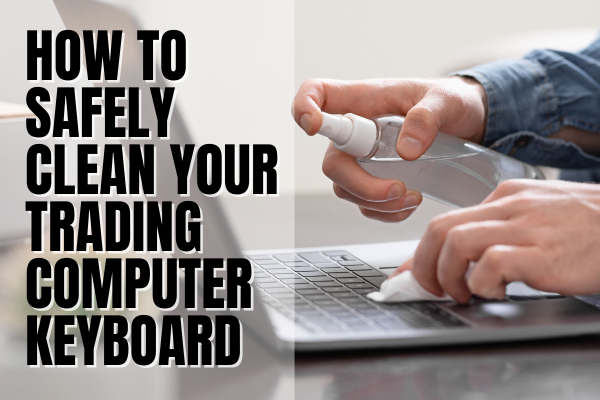
Here are some tips for maintaining a healthy trading environment by safely cleaning your trading computer keyboard. When you are a trader, cleaning your keyboard is probably the last thing on your mind. However, there’s some freak-out information that may put this task on your radar.
Your keyboard is 20,000 times dirtier than a toilet seat.
If your priorities have now suddenly changed, we don’t blame you. Just like regularly cleaning your bathroom at home, it’s important to clean your keyboard on a regular basis. Especially if you’re sharing a computer with others.
Below we lay out a few methods to safely clean your keyboard.
Safety First
Before you start cleaning, ensure there is no power to the keyboard. If you have a USB keyboard, unplug it. Remove the battery for a wireless keyboard. For anyone with a laptop, turn it off, disconnect it from battery backup, and allow it to cool.
This serves two purposes. First, you avoid any chance of damaging your equipment. Second, you avoid accidentally executing a command (or trade order) that you don’t intend.
Cotton Swab Method
For laptop keyboards or keyboards with chicklet-style caps, you can use a cotton swab and some rubbing alcohol. It’s always a good idea to test it on a single key or a small area of the keyboard before going for the whole thing.
Dip the cotton swab in rubbing alcohol, then run it between your thumb and forefinger to get rid of the excess. Run the swab over the keys and in between areas. You’ll be surprised at the amount of grime you pick up.
If rubbing alcohol is a problem for you, you can use a few drops of diluted detergent. Again, always test in a small area before proceeding.
Whatever liquid you use, you need to make sure it’s safe for your equipment. Read the owner’s manual before you proceed. Also, use any liquid in moderation.
Compressed Air Method
Many people aren’t aware they can buy compressed air in bottles. Computer technicians have been using compressed air on hardware components for a long time as a safe way to clean.
You can buy the air from Home Depot, office supply stores, online stores or even your local supermarket. It’s not expensive. You can get a can of compressed air for less than $10. If you are cleaning your trading computer in the office, your IT department might already have some.
The aerosol cans come with an extension tube. Use the tube to pinpoint the exact area you want to be cleaned. All you have to do is point and push the trigger. The air should blow out the unwanted dust and debris.
It should also loosen up anything in between the keys. So after using the compressed air, you can turn your keyboard upside down and shake it to get rid of the extra stuff.
This treatment can make a bit of a mess, so do it over a trashcan or outside.
Also, always keep the can upright so you’re blowing air. An upside-down can will blow propellent.
Tape or Post-It Method
Even with the above methods, it’s hard to get out some of the dirt and grime under and between the keys. You can use clear tape to get to that hidden stuff. Roll a piece of tape with the sticky side facing outside. Alternatively, you can use the sticky part of a Post-it Note.
Run your choice of dust trapper through the space between keys. Repeat the process a few times. Even on a relatively clean computer keyboard, you’ll be surprised by the amount of dirt and grime you pick up.
Conclusion
The above methods should help you safely get your computer keyboard as clean as possible. Mix and match these methods to get the maximum effect.
Experts recommend you clean your keyboard once or twice a month. Or, you could look at it this way: if it’s time to clean your bathroom, it’s time to clean your keyboard, too.
There are more trading computer tips like this in our EZ Trading Computers buyer’s guide. Check out our “How To Buy a Trading Computer” e-book.
We hope today’s Quick Tip helped you. If you found this helpful, you’ll want to check out the other computer How-To’s I’ve created on this page. You can always call us if you have questions: 800-387-5250
